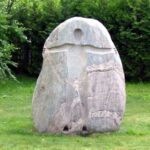
Ališanka Arvydas
Born:
March 15, 1963, in Vilnius, Lithuania
Education:
1982–1983, 1985–1989, 1990–1991 – Vilnius Academy of Arts, Department of Sculpture
Grants and Awards:
1997 – Annual Lithuanian State Grant for Young Artists
Solo Exhibitions:
1999 – Protection for the Body, “Akademija” Gallery, Vilnius
1997 – Private, countryside homestead, Zabarija, Trakai district
12 Sculptures, Mažeikiai Museum, Mažeikiai
1996 – Sculptures in the Basement, “Skliautai” Gallery, Vilnius
1988 – Exhibition of Ethnographic Drawings, National Library, Vilnius
Group Exhibitions:
Participating since 1988
About the Artist:
Sculptor Arvydas Ališanka leads a life marked by a steady annual rhythm.
Autumn is dedicated to teaching at the Vilnius Academy of Arts, in the Department of Ceramics, where he has taught since 1993.
Winter is for creating small-scale sculptures, a practice he has continued since his student years.
Spring and Summer are reserved for symposiums (often several per season) and the realization of large-scale public or private sculptures.
Over two decades of creative work, Ališanka has developed a distinct worldview, a personal understanding of sculpture, and a recognizable artistic style. His work strives for monumentality, even when addressing ephemeral subjects, while employing minimalist and restrained means. He deliberately emphasizes an archaic quality in his objects.
His sculptures are characterized by constructive form and always feature a striking silhouette. The expression is abstract and contemporary, yet infused with the breath of tradition, evident through symbols, ideas, exposed raw materials, and rough construction techniques like cutting or chiseling—evoking a sense of tradition embedded in the present.
Ališanka’s sculptures are deeply humanized—they are for people, about people, and explore the human condition within the material world. The human body is referenced through both durable and impermanent materials: stone, wood, bronze, ice, straw and fire, amber, paper—each chosen to reflect the thematic core of his works and serving as the central motif of his artistic expression.



